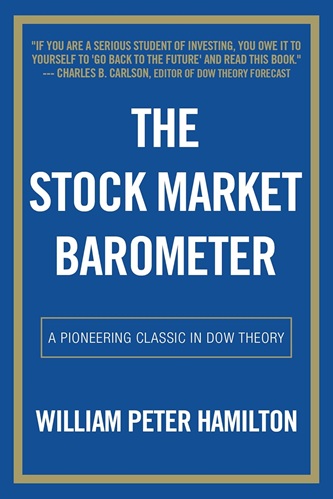William Peter Hamilton
William Peter Hamilton (January 20, 1867 – December 9, 1929), a proponent of Dow Theory, was the fourth editor of the Wall Street Journal, serving in that capacity for more than 20 years (i.e., January 1, 1908 – December 9, 1929).
-
- “Some people think and others do. Dow thought and created an index and pondered it. Hamilton [by contrast,] put it to practice as a workhorse. He was the first serious practitioner of [both] the art of forecasting future stock action based on precise prior action [and the] forecasting of the economy based on the market.
Journalist
Having earlier worked as a clerk on the London Stock Exchange, he began his career in journalism in London, in 1890, with The Pall Mall Gazette, under the editorship of William Thomas Stead (1849-1912).
In 1893 and 1894, he served in Africa as a Lieutenant in the Royal Engineers of the British Auxiliary Forces during the First Matabele War, and also as a corporal in the British Bechuanaland Police. He also served as a war correspondent for the Gazette during that time; and, once the war was over, he remained in Johannesburg, working as a financial journalist.
The Wall Street Journal
Having moved from South Africa to Australia, “where he represented London newspapers” (Hogate, 1929), he migrated to New York, and joined the staff of the Wall Street Journal in 1899.
On January 1, 1908, when Sereno S. Pratt, who had been WSJ’s editor since late 1905, and the author of The Work of Wall Street (1906), replaced George Wilson (1868-1908) as the secretary of the New York Chamber of Commerce, Hamilton was promoted — directly at the behest of Barron’s wife, Jessie Maria Barron (1852-1918), née Barteau, née Waldron — to the position of editor of the Wall Street Journal, where he eventually became a strong advocate of Dow Theory (see: “The six basic tenets of Dow Theory).
-
- “After (Charles Henry) Dow’s death in 1902 there followed in quick succession two editors of The Wall Street Journal who were not interested in Dow’s theories of market action. Only a year after Dow’s death, William Peter Hamilton, who had served as a reporter under Dow from 1899 to 1902, became an editorial writer and, in January, 1908, became editor. While this gives continuity, it should not be thought that Hamilton was an avid disciple of Dow’s. In the period 1903 to 1918, he mentioned the Dow theory in four editorials. It was not until he became interested in publishing a book of his own in 1922 that Hamilton began frequent reference to Dow’s theory. He mentioned Dow’s theory in four out of eight articles in 1921 and seven out of eleven articles in 1922. In the seven years following, he mentioned the theory in eleven out of forty-three editorials.” — Woodward, (1968), p.14.
- “Hamilton had an uncannay [sic] knowledge of market fluctuations [and, from this,] much of the authority gained by the [Dow] indices [is directly due to Hamilton’s efforts] since he chose to utilise them in enunciating his own generalisations, which were really grounded on an extremely sound knowledge of the market”. — Torliev Hytten, The Sydney Morning Herald, August 2, 1938.
- “William Hamilton, late editor of the “Wall-street Journal”, who wrote many leading articles on the theory first invented by Charles H. Dow, likened the movement of the averages to that of the sea; the tide, gradually coming in or going out, he compared with the primary or year-to-year market trend; the waves he represented as being the intermittent changes. In these broad movements which he called the secondary, or month-to-month trends; and he looked upon the ripples as being the day-to-day changes which are only important because they eventually form the secondary trend.” — The West Australian, September 28, 1937.
- “William Peter Hamilton . . . had an extraordinary flair for predicting market trends, apart from any scientific method of deduction as the result of studying Dow Jones averages. It is of interest that a few weeks before his death in November 1929 Hamilton correctly called attention to the beginning of the great bear market that was destined to run for nearly five years.” — The (Melbourne) Argus, October 18, 1937.
Death
He died at his Brooklyn, New York home of pneumonia on December 9, 1929. His funeral services were conducted at Grace Church, in Brooklyn, on Thursday, December 12, 1929.

